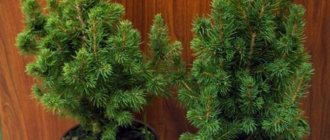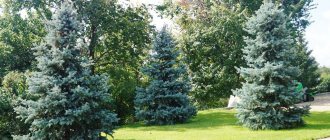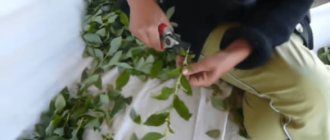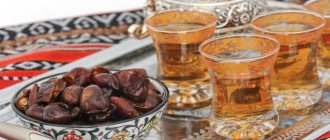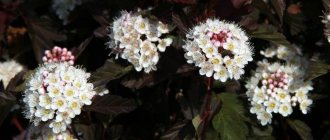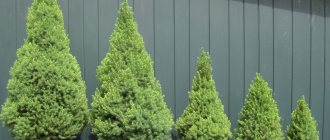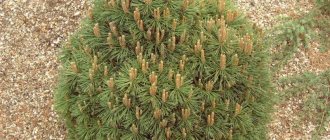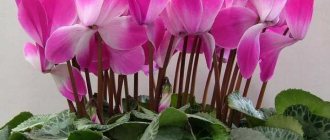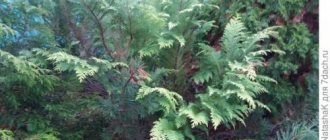For lovers of landscape art, conika spruce is familiar with its cultural forms. A small tree with a fluffy conical crown is used more often than other conifers by designers to decorate open ground, in the form of a tub plant - terraces, balconies and even home interiors.
Native to Canada in nature, it is the result of a natural mutation of the gray spruce, with an unusually regular cone-shaped crown. The plant has extreme endurance and unpretentiousness. These features make it possible to grow a tree in any region of Russia.
Botanical description
Canadian Spruce (Picea canadensis conica) is a dwarf variety of gray Spruce (Picea glauca) of the Pine family (Pinaceae). In some sources it is called Spruce Glauca Conica (Picea Glauca Conica). The very first of the species' hybrids was discovered. Cultivated since the beginning of the twentieth century. It has a natural, pronounced lowered conical crown shape that does not require correction.
The root system is compact but powerful, with a shortened taproot. With age, it grows horizontally close to the surface. Provides the plant with high wind resistance. Numerous branches growing from the very root are located in whorls, slightly curved with short internodes, forming a narrow, dense, strictly conical crown with a diameter of up to 2 m. The buds are brown, not resinous.
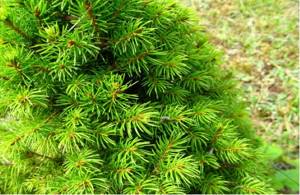
The bark of the trunk is thin, light brown, covered with small scales. Young shoots are grayish-yellow with a shine, in grooves with slight pubescence. The needles are sickle-shaped, very soft. Young needles are colored light green; with age they acquire a bluish tint. Their length is from 8 to 18 mm. When rubbed they have a pleasant smell.
Conica spruce (Picea conica) grows slowly: 3-6 cm per year. Further growth slows down to 2-3 cm per year. By the age of 10 years, the tree will have risen 1.5 m; at 30 years old - 2-2.4 m. In favorable conditions, the height of an adult tree reaches a maximum of 3-4 m.
The crown of a small seedling is shapeless, but at 6-7 years of age a growth peak of up to 10 cm occurs and the crown becomes pubescent and takes on the correct shape.
Fruiting of Konica is a rare phenomenon. If it happens, small bright brown cones densely cover the branches from the middle of the tree to the top, serving as an additional decoration. The lifespan of Glauka Koniki in the landscape is 30-50 years.
How to take care of a miniature Christmas tree at home and on the property?
Growing spruce is conventionally divided into 2 stages: at home (in a greenhouse) and in open ground. In order for the seedling to become stronger in the first years, it is kept in a cool room in the summer up to +10°C degrees, and in the winter down to -10°C. Watering is carried out as the top layer of soil dries. In warm weather, spraying the crown with water from a spray bottle is allowed.
Knowing how to care for the Canadian conifer on your site, you don’t have to worry about its decorativeness. Agricultural technology is as follows:
- Moderate watering is required. In the warm season, 10 liters per tree 2 times a week is enough.
- Sprinkling twice a week will be useful. A watering can or hose is used. In this case, there is no need to make a swamp in the root circle; excess moisture is harmful to the roots.
- Sometimes it is necessary to loosen the soil around the trunk to ensure the flow of oxygen to the roots. This is done extremely carefully, since the roots are located close to the surface.
- After loosening, mulching is done with peat and compost.
Dwarf Konika spruce trees require fertilizer during their growth period at home. Special complexes for conifers are suitable. If mineral complex fertilizers were added during planting, they will last for several years. Organic fertilizers are also suitable for spruce. Once per season, 5 kg of rotted manure can be added to the soil.
- Covering and pruning
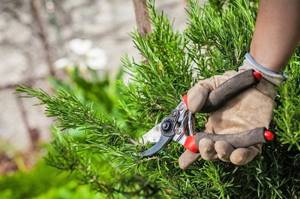
In winter, Christmas trees growing in the garden must be protected from frost. To do this, the trees are wrapped in burlap and tied up. The lower part of the trunk must remain open, otherwise the process of debate will begin. Shelter is needed more to protect from the first spring sun than from the cold. Canadian Christmas trees are frost-resistant representatives. The roots of young and immature seedlings can be protected from freezing with mulch. Adult specimens do not need shelter.
The pruning procedure is only necessary if the branches are burnt or dry. They can be safely deleted. The spruce grows well, and with the onset of spring, young branches will certainly appear. To stimulate their growth, you need to slightly increase watering.
Canadian blue spruce has been successfully grown in home gardens for about a hundred years. Even a novice gardener can grow a decorative and healthy tree with unusual needles. You just need to start correctly: plant it in the right place. The rules for further care of a coniferous dwarf are not complicated.
The Canadian Konika spruce, well recognized anywhere, wins the heart at first sight, because it helps to recharge with positivity thanks to its all-season decorative effect, healing aroma of resins, durability and ease of care. That is why more and more people want to have it closer to home. However, in order for the plant to initially have everything it needs for proper growth and development, it is assumed that a number of features are observed in planting and caring for the Canadian Konica spruce.

Variety varieties
The biological feature of the low-growing Canadian spruce Konica, which contributes to the natural degeneration of the variety, served as the basis for the creation of new dwarf hybrids. How this happens remains a mystery.
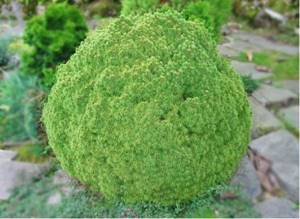
Varieties derived from natural mutation:
- Picea glauca conica Alberta Globe. The Alberta Globe variety has been cultivated since 1967. A dwarf variety with a spherical crown. At 10 years of age, the crown diameter is about 30 cm. The maximum height of an adult plant is 90 cm with a crown width of 120 cm. Frost-resistant. Awarded a gold medal in 1968.
- Picea glauca conica Blue Wonder. It has become known since 1984. It is characterized by rapid growth: at the age of 5, growth increases to 20 cm; by the age of 20 it reaches 2 meters in height and 80 cm in volume; The color of the needles is blue-green. The parameters depend on the habitat and growing conditions.
- Picea glauca conica Gnom. A low-growing form with gray-green needles and a narrow pyramidal crown, it grows just over a meter.
- Picea glauca conica Daisy`s White. Slow growing variety. It is distinguished by the variability of its needles from yellow to white; after six months the needles turn green.
The popularity of conifers in the landscape, frost resistance and ease of care encourage breeders to create hybrid forms. Every year, the assortment of nurseries is replenished with both mutant varieties and selection products.
The Maigold variety (Picea glauca conica Maigold) has become widespread in Russia. Opened in 1979 in Belgium. Characteristics and appearance are similar to Daisy White. In our climate, a 10-year-old tree reaches only 80 cm. With the same data, a new variety of selection, Sun on the Sky (Picea glauca Sun on the Sky).
Very popular bluish coniferous varieties: Sanders Blue (Picea glauca Sander`s Blue), Alberta Blue (Alberta Blue) and various hybrids.
Planting seedlings
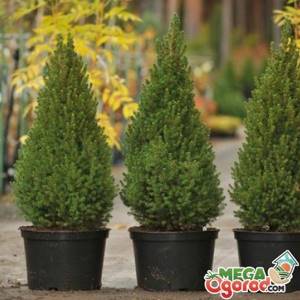
Only those trees that are 4-5 years old are planted in the ground. Before this, it is recommended to keep the plants in special pots. This period is maintained so that the root system of the spruce, which is located mainly on the surface, becomes stronger. But for a longer period, Canadian conica should not grow in pots indoors, as this can lead to the death of the plant.
It is recommended to plant in open ground in cool or cloudy weather so that the sun does not dry out the soil and roots.
If the seedling was purchased with closed roots, then for this process you can choose an early spring month, when the snow has just melted. If the spruce tree has a bare root system, then to plant it you need to wait until the weather is consistently warm, not hot, and the soil has warmed up sufficiently.
Before planting, it is necessary to prepare the soil. To do this, organic or mineral complex fertilizers for coniferous crops are applied to the hole. The soil is well watered to make it easier for the root system to adapt. After planting, the plant must be shaded from direct sunlight for several days. This will protect the needles from withering and rapid evaporation of moisture.
Spreading
In its natural habitat, Glauka is found in the habitats of its ancestor, the gray spruce (picea glauca): in the forests and foothills of Canada from Labrador to Alaska, where it was discovered in 1904 on the shores of Lake Lagan. The plant is not uncommon; under natural conditions it is long-lived and grows up to 5 m in height. The original shape of the crown, which does not require formation, and wind resistance served as a basis for its spread to other regions. Grows successfully in areas where other spruce trees grow.
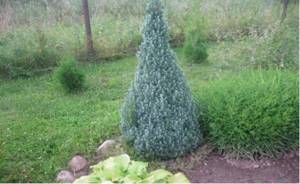
Konica spruce is artificially bred in nurseries in the Netherlands, Holland and Russia for landscaping, decorating room interiors, and is used as wind protection. On the eve of the New Year holidays, gift konika spruce trees with soft, safe needles and a real spruce scent are purchased as a festive attribute.
Features of transplanting Konika spruce into open ground, purchased or gifted for the New Year
If you bought or were given a Glauka Konik spruce in the winter, and you were able to keep it in proper condition, then with the onset of spring, when the snow melts, the conifer must be transplanted into open ground.
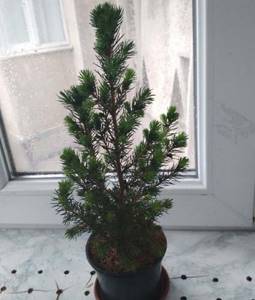
By the way! about how to care for Konika at home before transplanting it into open ground , if it was given to you (you bought it) in winter .
BUT! It is much more correct to buy seedlings in the spring or autumn , and always in special nurseries or garden centers , and not at a New Year's sale.

Mandatory actions that are performed when planting Konica, which you nursed at home and then transplanted into open ground in the spring:
- With the onset of spring, you should gradually begin to harden Konica by taking it out into the fresh air, preferably not in an open place, but for example, under a canopy. First for 5-10 minutes, then for half an hour, for several hours, and then for the whole day.
- Spray the needles with Epin before and after planting.
- Irrigate the root system of the plant with a solution of “Kornevin” or “Heteroauxin”.
- Mulch the tree trunk circle, and also cover (shade from the sun) the crown with spruce branches or white cotton cloth (for example, the same gauze).
- You need to water and irrigate the crown very carefully (again, preferably with settled or rainwater), and in the first days almost every day (morning or evening).
Attention ! Even if you do everything correctly, it is not a fact that the plant will take root and take root in the open ground (it is especially important that it can survive the winter), because it is already accustomed to indoor conditions.
Worth knowing! Potted Koniks sold in supermarkets are temporary decorative Christmas trees that are a New Year's item and are usually used as disposable plants.
But, of course, there is always a chance to save the plant from death...
Planting and care
Canadian spruce Konica is unpretentious and hardy, but proper planting and nuances of care will significantly extend its healthy life and decorative appearance. When choosing a zone, you should take into account its low resistance to dust and gas contamination. Landing within the city and near the road is not recommended.
Where to plant Konica
Konica spruce has a positive attitude towards the sun, but is afraid of the burning rays of spring - the soft sensitive needles burn out, and the recovery process is long. Tolerates light shade, but canopy density may suffer. An open, free, ventilated space on the sunny side of a plot with moisture-absorbing fertile soil is an ideal planting site. Constriction by trees or buildings threatens Konika with diseases.
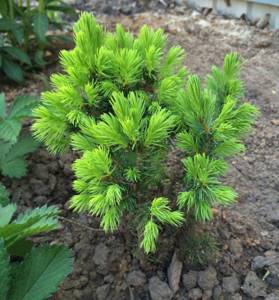
The density and splendor of the crown depend on the composition of the soil. Loams fertilized with humus with a pH of 4-5.5 contribute not only to decorative properties, but also to healthy longevity. Konica spruce will grow in any soil, but it is worth ensuring breathability and sufficient moisture.
When to plant
The favorable time to plant or transplant Glauka seedlings into open ground depends on the climatic conditions of the region. In central Russia it is spring, late April or early May. Over the summer, the tree will take root well and grow stronger if you water it regularly. In the fall, at the beginning of September, there is also time to take root before frost, especially if the autumn is rainy. There is sufficient accumulation of moisture by the roots, and the autumn coolness and air humidity will help to adapt faster.
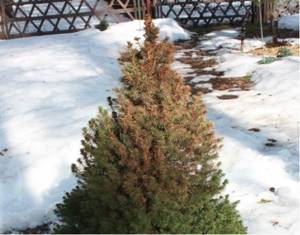
Spring sunburn on a conifer. Covering with special material will prevent troubles
As for specimens with a closed root system, they are planted at any time of the growing season, but cool soil promotes healthy rooting.
Selection of seedlings and planting algorithm
Mostly, Canadian Konica spruce is sold in containers. Pay attention to the flowerpot. In a good plant, the diameter of the pot corresponds to the circumference of the crown, because its roots are powerful and take up a lot of space. A small container cramps them, the suction roots die off, making rooting difficult. Juicy healthy greenery and a large flowerpot are the criteria for choosing a seedling.
Before planting, the flowerpot with Konika is thoroughly saturated with water so that when removing it from the flowerpot, the suction roots are not damaged. The tree is planted to the depth of an earthen clod. If the root system is open, the root collar is located at surface level.
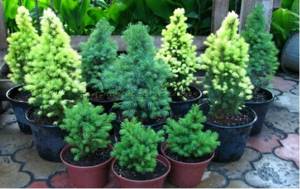
Landing algorithm:
- At the intended planting site, dig up the soil 15-20 cm deeper and wider than the size of the flowerpot so that the roots spread freely.
- The soil is enriched with humus, acidic peat, and superphosphate.
- The planting hole corresponds to the height of the flowerpot, but is wider so that it is possible to cover the roots with soil.
- Freed from the flowerpot, the seedling is placed in a hole.
- The free space is filled with earth and compacted.
The soil is thoroughly watered and mulched. Peat, coniferous litter, and softwood sawdust are used as mulch. This material helps maintain soil acidity.
Nuances of care
The peculiarity of Glauka is that she requires a minimum of attention. In hot, dry weather, watering with crown irrigation will be required. It is held late in the evening. Weeds are removed from the tree trunk in a timely manner, while loosening shallowly. Formation of the crown of Konike is not required, but sanitary pruning in the spring is carried out every year. She easily tolerates a curly haircut.
Optimal time for curly pruning: early spring (March-April). The sections are treated with garden ointment with a fungicide, preventing fungal infection
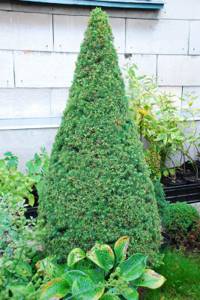
To protect delicate needles from spring solar aggression and severe frosts, shelter is required. All kinds of shields, wrappings with burlap or other material are used. The protection is designed in such a way that it dissipates the sun's rays, but does not interfere with ventilation.
An important stage in caring for Konica spruce is maintaining the nutritional value of the soil. Excess nitrogen is harmful to conifers. Potassium, magnesium and phosphorus are the main minerals that supplements should contain. Nitrogen is also needed, but in minute quantities.
In the spring, 3-5 kg of humus is added to the tree trunk circle, carefully mixing with the top layer of soil. In the fall, feed with a potassium-phosphorus mixture. Mulch with a 5-10 cm layer of peat, which is also embedded in the ground in the spring. Special additives for conifers also saturate the soil with minerals.
When to plant (transplant) Canadian spruce Konica in open ground: optimal timing
It is better to plant Konica so that the spruce is well rooted and strong by winter, but planting can also be done in the fall . For example, for the Middle Zone, the approximate planting dates for Koniki spruce in the spring are late April - early May, and in the fall - late August - early September.
However, if your autumn is long and warm (you live in the south of Russia), and in the spring it is most often “from boots to sandals”, in other words, the heat can quickly set in (and the spruce that has not yet taken root will get sunburned), then it is better to plant Konik at this autumn time.
Note! However, container plants can be planted all year round. Nevertheless, the period when young growths actively begin to form is considered not very successful.
If you were able to purchase a seedling only in the summer , then after planting you should regularly (once a week) abundantly water the young spruce, pouring out at least 10 liters, and also carry out shallow loosening (5-6 cm).
It is also believed that it is very good to plant conifers in winter , because... at this time of year, trees are completely at rest (sleeping), which means they will be less damaged and, accordingly, the adaptation process will be much easier.
Reproduction of Canadian spruce Konica
Gardeners increase the number of conifers on their site using cuttings. There is no other way to propagate Glauka. 1 or 2 year old shoots are rooted. Cuttings are cut from the middle branches of the tree in the summer (June-July) on a cloudy day or evening.
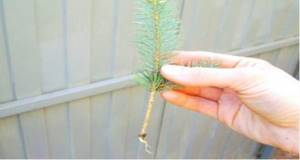
The shoots with a heel measuring 8-11 cm are more viable. The planting material is kept in a growth stimulator for 24 hours. The cuttings are placed in a container with moist, fertile, loose soil, deepened by 2-3 cm.
The seedlings are provided with greenhouse conditions with regular ventilation and necessary moisture. The rooting process is long, about 24 weeks. In the process, fertilizing with mineral additives is carried out for conifers.
Propagation of Canadian spruce trees using cuttings
The tree propagates by seeds and cuttings. The best planting time for dwarf forms is spring and early summer; large plants are best replanted in winter. Let's consider a more accessible method of propagation - cuttings. This process is lengthy, but more reliable. It is better to carry it out in June; over the summer the seedlings will have time to take root well and prepare for winter. Lower branches up to 10-12 cm in size are torn off from the mother spruce.
Preparing spruce cuttings
The cutting must have a piece of bark from the mother plant - a “heel”, otherwise it simply will not take root.
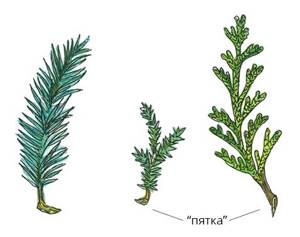
A piece of bark from the mother plant - “heel”
Before planting, the lower part of the prepared spruce cuttings is treated with growth stimulants (for example, in Epine solution for about two hours). Next, the solution is diluted with water and used to water the substrate with planted cuttings, which are deepened into the substrate by about 2 cm. Please note that moisture in the substrate should be maintained constantly, but in moderation. Thus, there is nothing difficult in planting itself, and caring for a dwarf Christmas tree is even simpler.
Despite its simplicity, Canadian spruce, like other conifers, requires care and attention. This is especially important when choosing a place for planting, preparing the hole and planting itself. The correct implementation of these processes affects the general condition and growth of conifers in the future.
Proper care of Canadian spruce and its varieties consists of ensuring optimal watering regime, timely fertilizing and, if necessary, protection from pests.
Canadian spruce loves sunny places, but the scorching sun can cause the needles to burn. This phenomenon is due to the fact that with a sharp increase in solar activity, the soil does not have time to thaw and the root system has not yet become active. But the needles have already become active, evaporating moisture and, not receiving it from the roots, begin to dry out and turn brown.
This can usually be seen on a tree on the side facing the sun. Therefore, it is recommended to water spruce trees, especially young seedlings, before the onset of frost in the fall, and in the spring to protect the branches from the sun, for example, by covering them with burlap or paper.
Diseases and pests
The Canadian Konica spruce, like all plants, develops diseases due to improper placement, agricultural practices, and lack of attention. If a red coating appears on the branches and the needles fall off, this is tracheomycosis, which affects the roots of young trees. The disease cannot be cured. Dangerous for surrounding plants. There is no treatment. The tree is burned along with the roots, and the place where it grew is treated with a fungicide.
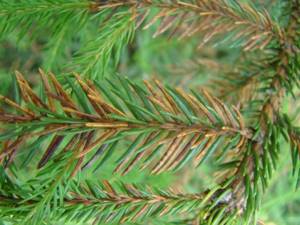
Pine needle rust is a fungal disease. The signs of the disease are clear and easily distinguishable: small 0.5 cm orange growths (spore carriers) appear on the bark of the shoots. After some time, the needles turn yellow and fall off. Treatment: spraying with copper-containing preparations. Treatment is carried out several times during the month. It is not recommended to plant pome fruit crops next to conifers: apple tree, pear tree, as they are an “incubator” for rust spores.
An equally dangerous fungal disease is Schutte. It occurs from stagnant moisture in cramped and weed-filled plantings. It appears in early autumn as drying, yellowing of the needles with barely noticeable brown spots. The following spring, the needles turn black, become covered with plaque and fall off, becoming a source of infection. Treatment: fallen pine needles, cut diseased branches are burned, treated several times with fungicides or copper-containing preparations.
Glauka often suffers from root rot, which occurs from stagnant moisture in poorly aerated soils. By mid-summer the plant looks depressed, growth growth is poor. The tree is dug up, the damaged softened roots are cut off, and transplanted to a new, more favorable place.
There are several dozen insect pests, some sucking and gnawing: aphids, scale insects, false scale insects, mealybugs, spider mites and others. They are difficult to notice as they are very small, but cause great damage by sucking juices from bark, pine needles or roots. A visible sign is a sticky coating on the vegetative parts. Pest control includes mechanical and chemical methods. Preventive spring treatments with insecticides are an effective remedy. Preparations: Pinocid, Extraflor (garlic based).
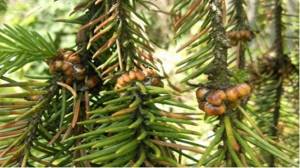
Colonies of scale insects. Trees growing in the shade and on dry soils suffer. Spraying with the insecticide Actellik, Aktara, Bitoxibacillin will help get rid of the pest.
Care
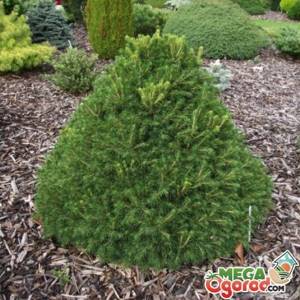
To plant Canadian spruce, it is recommended to select a place that is protected from drafts, well lit, and lightly shaded. The soil should be fertile and loamy. It is undesirable for groundwater to flow through the area where the tree grows. It is also good to plant spruce on the plain; in high places it can be too windy and dry, and depressions and depressions usually collect a large amount of water, which also negatively affects the plant.
Canadian conica needs regular watering, especially during hot summer days and dry periods.
The soil under the plant must be constantly moist so that the surface roots do not dry out. But excessive watering can lead to waterlogging of the soil. This also negatively affects the spruce root system. On hot days, it is recommended to water the plant through the crown, that is, completely spray it with a hose.
After watering, 1-2 days later it is necessary to loosen the soil to allow enough oxygen to pass through to the root system. At the same time, all weeds are removed. The process must be carried out carefully so as not to damage the root system.
Feeding:
- Canadian conika needs annual spring feeding. During this period, special complex fertilizers for coniferous plants are applied under the tree or rotted compost is added, which is mixed in equal parts with peat.
- It is worth remembering that the root system of the spruce is almost on the surface, so compacting the soil cannot be done.
Konica is a frost-resistant plant, so it does not need shelter for the winter period. But it is recommended to protect the needles from the spring sun. During the period when the sun becomes quite bright and warm, and the snow has not yet melted, the reflected rays can cause great harm to the plant. It is recommended to cover the crown with burlap or cardboard shields so that air can easily circulate around the spruce and the material does not come into contact with the needles too tightly. The crown of the conic has the correct conical shape by nature. There is no need for pruning.
Using dwarf spruce in the landscape
Konika spruce is an ideal tree for creating landscape compositions. Slow growth allows the tree to be used even in a flower bed, rock garden, or as a frame for paths. Planted as a repeating element in front gardens and ridges. The shape and color of the crown fits perfectly with any flowers and shrubs.
In the design of mixed-style gardens, conika spruce emphasizes the beauty of neighboring plants or itself acts as the center of the group.
Growing Konika spruce on the site will not take much time and will not create much trouble if you approach this issue correctly. The correct location of the tree accentuates the sophistication of the composition.
Glauka Konica in landscape design
Over the years, the plant increases in size, and it becomes impossible to keep it in a pot at home. Then the bush is transplanted to the site. With age, the needles thicken, and Konika forms a dense, wide cone. This form is convenient for decorating a site and easily fits into any idea of a landscape designer.
We recommend checking out Avocado Mousse
Prickly spruce Glauka Globoza combines well with Konika: a small blue spruce fills the background well in front of a four-meter bright green plant. A mix with other dwarf spruce trees is also widely used in landscape design. A good combination with dwarf thujas, for example with western Danica.

Single and group plantings look good only with Glauka Konica spruce.
